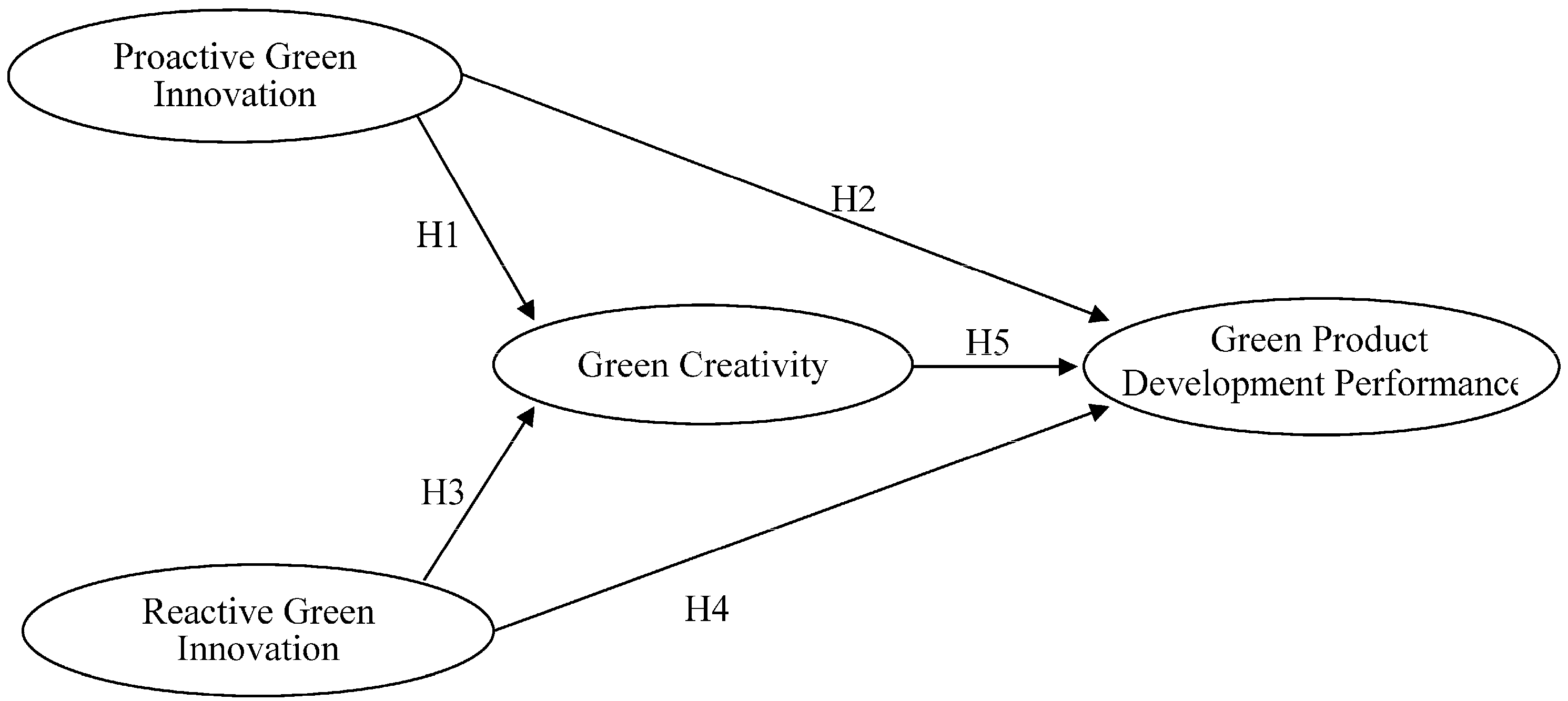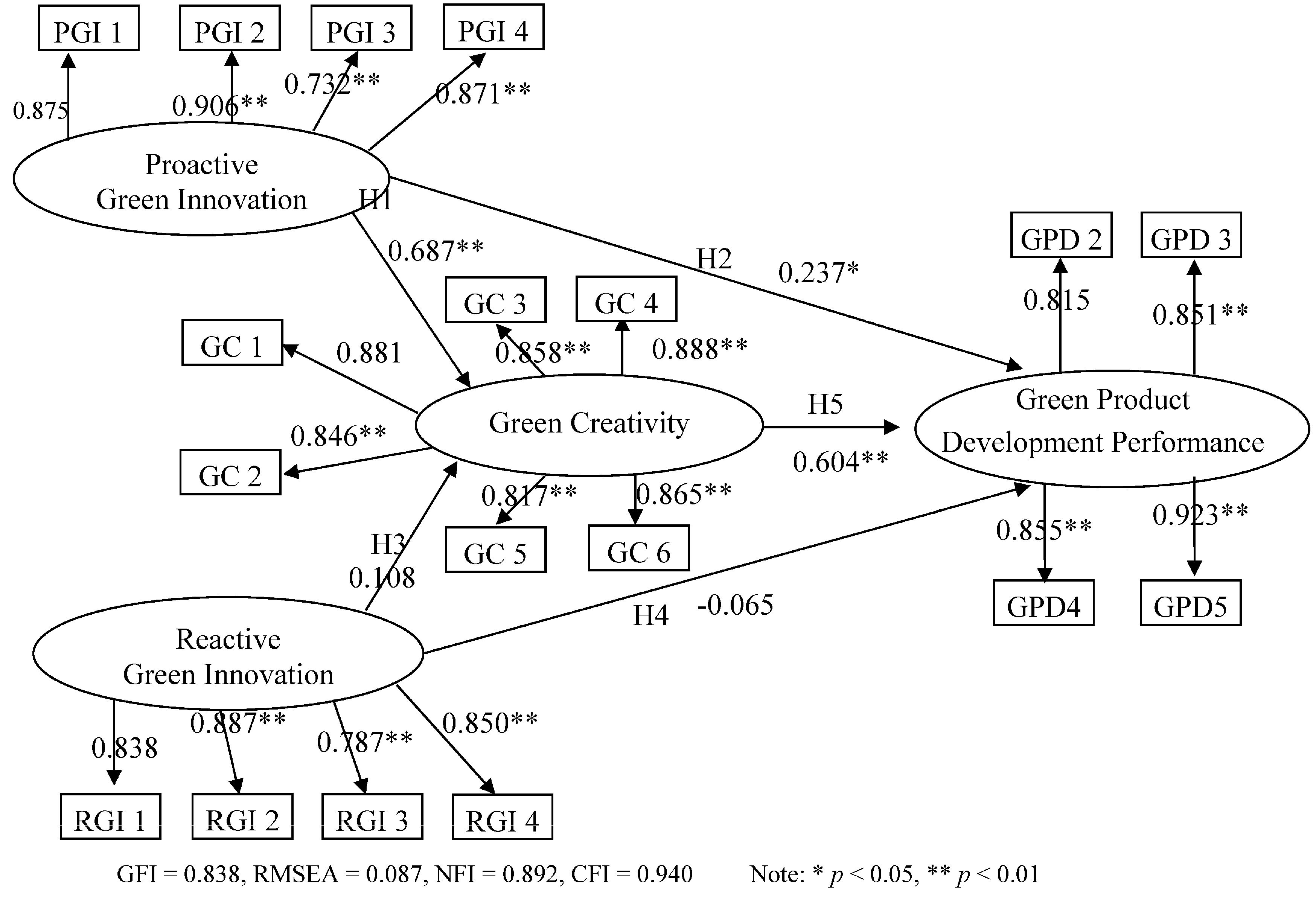The Influence of Proactive Green Innovation and Reactive Green Innovation on Green Product Development Performance: The Mediation Role of Green Creativity
Abstract
:1. Introduction
2. Literature Review and Hypothesis Development
2.1. The Positive Effect of Proactive Green Innovation on Green Creativity
2.2. The Positive Effect of Proactive Green Innovation on Green Product Development Performance
2.3. The Positive Effect of Reactive Green Innovation on Green Creativity
2.4. The Positive Effect of Reactive Green Innovation on Green Product Development Performance
2.5. The Positive Effect of Green Creativity on Green Product Development Performance
3. Methodology and Measurement
3.1. Data Collection and the Sample
3.2. Definitions and Measurements of the Constructs
4. Empirical Results
4.1. The Results of the Measurement Model
4.2. The Results of the Structural Models
5. Conclusions and Implications
Acknowledgments
Author Contributions
Conflicts of Interest
References
- Chen, Y.S.; Chang, C.H.; Lin, Y.H. The Determinants of green radical and incremental innovation performance: Green shared vision, green absorptive capacity, and green organizational ambidexterity. Sustainability 2014, 6, 7787–7806. [Google Scholar] [CrossRef]
- Chen, Y.S. Green organizational identity: Sources and consequence. Manag. Decis. 2011, 49, 384–404. [Google Scholar] [CrossRef]
- Chen, Y.S.; Chang, C.H.; Lin, Y.H. Green Transformational leadership and green performance: The mediation effects of green mindfulness and green self-efficacy. Sustainability 2014, 6, 6604–6621. [Google Scholar] [CrossRef]
- Chen, Y.S.; Chang, C.H. Enhance green purchase intentions: The roles of green perceived value, green perceived risk, and green trust. Manag. Decis. 2012, 50, 502–520. [Google Scholar] [CrossRef]
- Chen, Y.S.; Lin, Y.H.; Lin, C.Y.; Chang, C.W. Enhancing green absorptive capacity, green dynamic capacities and green service innovation to improve firm performance: An analysis of structural equation modeling (SEM). Sustainability 2015, 7, 15674–15692. [Google Scholar] [CrossRef]
- Chen, Y.S. The drivers of green brand equity: Green brand image, green satisfaction, and green trust. J. Bus. Ethics 2010, 93, 307–319. [Google Scholar] [CrossRef]
- Chen, Y.S.; Lin, C.Y.; Weng, C.S. The influence of environmental friendliness on green trust: The mediation effects of green satisfaction and green perceived quality. Sustainability 2015, 7, 10135–10152. [Google Scholar] [CrossRef]
- Chen, Y.S.; Chang, C.H. The determinants of green product development performance: Green dynamic capabilities, green transformational leadership, and green creativity. J. Bus. Ethics 2013, 116, 107–119. [Google Scholar] [CrossRef]
- Chen, Y.S.; Lai, S.B.; Wen, C.T. The influence of green innovation performance on corporate advantage in Taiwan. J. Bus. Ethics 2006, 67, 331–339. [Google Scholar] [CrossRef]
- Chen, Y.S. The driver of green innovation and green image—Green core competence. J. Bus. Ethics 2008, 81, 531–543. [Google Scholar] [CrossRef]
- Cronin, J.J., Jr.; Smith, J.S.; Gleim, M.R.; Ramirez, E.; Martinez, J.D. Green marketing strategies: An examination of stakeholders and the opportunities they present. J. Acad. Mark. Sci. 2011, 39, 158–174. [Google Scholar] [CrossRef]
- Chen, Y.S.; Chang, C.H.; Wu, F.S. Origins of green innovations: The differences between proactive and reactive green innovations. Manag. Decis. 2012, 50, 368–398. [Google Scholar] [CrossRef]
- Covin, J.G.; Slevin, D.P. Strategic management of small firms in hostile and benign environments. Strateg. Manag. J. 1989, 10, 75–87. [Google Scholar] [CrossRef]
- Gladwin, T.N.; Kennelly, J.J.; Krause, T.S. Shifting paradigms for sustainable development: Implications for management theory and research. Acad. Manag. Rev. 1995, 20, 874–907. [Google Scholar]
- Sharma, S.; Henriques, I. Stakeholder influences on sustainability practices in the Canadian forest products industry. Strateg. Manag. J. 2005, 26, 159–180. [Google Scholar] [CrossRef]
- Aragon-Correa, J.A.; Sharma, S. A contingent resource-based view of proactive corporate environmental strategy. Acad. Manag. Rev. 2003, 28, 71–88. [Google Scholar]
- Hart, S.L. A natural-resource-based view of the firm. Acad. Manag. Rev. 1995, 20, 986–1014. [Google Scholar]
- Moss, T.W.; Neubaum, D.O.; Meyskens, M. The effect of virtuous and entrepreneurial orientations on microfinance lending and repayment: A signaling theory perspective. Entrep. Theory Pract. 2015, 39, 27–52. [Google Scholar] [CrossRef]
- Amabile, T.M. A model of creativity and innovation in organizations. Res. Organ. Behav. 1988, 10, 123–167. [Google Scholar]
- Barczak, G.; Lassk, F.; Mulki, J. Antecedents of team creativity: An examination of team emotional intelligence, team trust and collaborative culture. Creativity Innov. Manag. 2010, 19, 332–345. [Google Scholar] [CrossRef]
- Calantone, R.J.; Vickery, S.K.; Dröge, C. Business performance and strategic new product development activities: An empirical investigation. J. Prod. Innov. Manag. 1995, 12, 214–223. [Google Scholar] [CrossRef]
- Brown, S.L.; Eisenhardt, K.M. Product development: Past research, present findings, and future directions. Acad. Manag. Rev. 1995, 20, 343–378. [Google Scholar]
- Krishnan, V.; Ulrich, K.T. Product development decisions: A review of the literature. Manag. Sci. 2001, 47, 1–21. [Google Scholar] [CrossRef]
- Loureiro, M.L.; McCluskey, J.J.; Mittelhammer, R.C. Will consumers pay a premium for eco-labeled apples? J. Consum. Aff. 2002, 36, 203–219. [Google Scholar] [CrossRef]
- Zhang, T.; Gensler, S.; Garcia, R. A study of the diffusion of alternative fuel vehicles: An agent-based modelling approach. J. Prod. Innov. Manag. 2011, 28, 152–168. [Google Scholar] [CrossRef]
- Chen, C. Design for the environment: A quality-based model for green product development. Manag. Sci. 2001, 47, 250–263. [Google Scholar] [CrossRef]
- Azzone, G.; Noci, G. Seeing the environment as a source of change. J. Organ. Chang. Manag. 1998, 11, 94–111. [Google Scholar] [CrossRef]
- Lee, S.-Y.; Rhee, S.-K. The change in corporate environmental strategies: A longitudinal empirical study. Manag. Decis. 2007, 45, 196–216. [Google Scholar] [CrossRef]
- Henriques, I.; Sadorsky, P. The relationship between environmental commitment and managerial perceptions of stakeholder importance. Acad. Manag. J. 1999, 42, 87–99. [Google Scholar] [CrossRef]
- Liu, C.Y.; Wu, C.H. Environmental consciousness, reputation and voluntary environmental investment. Aust. Econ. Pap. 2009, 48, 124–137. [Google Scholar] [CrossRef]
- Ayag, Z. An integrated approach to evaluating conceptual design alternatives in a new product development environment. Int. J. Prod. Res. 2005, 43, 687–713. [Google Scholar] [CrossRef]
- Fitzsimmons, J.A.; Kouvelis, P.; Mallick, D.N. Design strategy and its interface with manufacturing and marketing: A conceptual framework. J. Oper. Manag. 1991, 10, 398–415. [Google Scholar] [CrossRef]
- Orsato, R.J. Competitive environmental strategies: When does it pay to be green? Calif. Manag. Rev. 2006, 48, 127–143. [Google Scholar] [CrossRef]
- Lumpkin, G.T.; Dess, G.G. Clarifying the entrepreneurial orientation construct and linking it to performance. Acad. Manag. Rev. 1996, 21, 135–172. [Google Scholar]
- Halbesleben, J.R.B.; Novicevic, M.M.; Harvey, M.G.; Buckley, M.R. Awareness of temporal complexity in leadership of creativity and innovation: A competency-based model. Leadersh. Q. 2003, 14, 433–454. [Google Scholar] [CrossRef]
- Chang, S.-C.; Tein, S.-W.; Lee, H.-M. Social capital, creativity, and new product advantage: An empirical study. Int. J. Electron. Bus. Manag. 2010, 8, 43–55. [Google Scholar]
- Hunt, S.D.; Morgan, R.M. The comparative advantage theory of competition. J. Mark. 1995, 59, 1–15. [Google Scholar] [CrossRef]
- Cooper, R.G. The dimensions of industrial new product success and failure. J. Mark. 1979, 43, 93–103. [Google Scholar] [CrossRef]
- Deshpande, R.; Farlet, J.U.; Webster, F.E. Corporate culture, customer orientation, and innovativeness in Japanese firms: A quadrad analysis. J. Mark. 1993, 57, 23–37. [Google Scholar] [CrossRef]
- Griffin, A. The effect of project and process characteristics on product development cycle time. J. Mark. Res. 1997, 34, 24–35. [Google Scholar] [CrossRef]
- Ford, C.M. A theory of individual creative action in multiple social domains. Acad. Manag. Rev. 1996, 21, 1112–1142. [Google Scholar]
- Pirola-Merlo, A.; Mann, L. The relationship between individual creativity and team creativity: Aggregating across people and time. J. Organ. Behav. 2004, 25, 235–257. [Google Scholar] [CrossRef]
- Bain, P.; Mann, L.; Pirola-Merlo, A. The innovation imperative: The relationships between team climate, innovation, and performance in research and development teams. Small Group Res. 2001, 32, 55–73. [Google Scholar] [CrossRef]
- Yoon, S.W.; Song, J.H.; Lim, D.H.; Joo, B.K. Structural determinants of team performance: The mutual influences of learning culture, creativity, and knowledge. Hum. Resour. Dev. Int. 2010, 13, 249–264. [Google Scholar] [CrossRef]
- Smith, P.G.; Reinertsen, D.G. Shortening the product development cycle. Res. Technol. Manag. 1992, 35, 44–49. [Google Scholar]
- Hair, J.F.; Anderson, R.E.; Tatham, R.L.; Black, W.C. Multivariate Data Analysis; Prentice-Hall, Inc.: Upper Saddle River, NJ, USA, 1998. [Google Scholar]
- Fornell, C.; Larcker, D.F. Evaluating structural equation models with unobservable variables and measurement error. J. Mark. Res. 1981, 18, 39–50. [Google Scholar] [CrossRef]
- Ioppolo, G.; Cucurachi, S.; Salomone, R.; Saija, G.; Shi, L. Sustainable local development and environmental governance: A strategic planning experience. Sustainability 2016, 8, 180–195. [Google Scholar] [CrossRef]


| Constructs | Mean | Standard Deviation | A | B | C |
|---|---|---|---|---|---|
| A. Proactive green innovation | 3.475 | 0.8725 | |||
| B. Reactive green innovation | 3.623 | 0.8800 | 0.386 ** | ||
| C. Green creativity | 3.664 | 0.7989 | 0.605 ** | 0.319 ** | |
| D. Green product development performance | 3.144 | 0.8304 | 0.616 ** | 0.203 * | 0.659 ** |
| Constructs | Number of Items | Number of Factors | Accumulation Percentage of Explained Variance |
|---|---|---|---|
| Proactive green innovation | 4 | 1 | 78.63% |
| Reactive green innovation | 4 | 1 | 77.92% |
| Green creativity | 6 | 1 | 79.81% |
| Green product development performance | 5 | 1 | 73.19% |
| Constructs | Items | λ | Cronbach’s α | AVE | |
|---|---|---|---|---|---|
| Proactive green innovation | PGI1 | 0.875 | 0.902 | 0.721 | 0.849 |
| PGI2 | 0.906 ** | ||||
| PGI3 | 0.732 ** | ||||
| PGI4 | 0.871 ** | ||||
| Reactive green innovation | RGI1 | 0.838 | 0.860 | 0.707 | 0.841 |
| PGI2 | 0.887 ** | ||||
| PGI3 | 0.787 ** | ||||
| PGI4 | 0.850 ** | ||||
| Green creativity | GC1 | 0.881 | 0.949 | 0.748 | 0.865 |
| GC2 | 0.846 ** | ||||
| GC3 | 0.858 ** | ||||
| GC4 | 0.888 ** | ||||
| GC5 | 0.817 ** | ||||
| GC6 | 0.865 ** | ||||
| Green product development performance | GPD2 | 0.815 | 0.919 | 0.743 | 0.862 |
| GPD3 | 0.851 ** | ||||
| GPD4 | 0.855 ** | ||||
| GPD5 | 0.923 ** |
| Hypothesis | Proposed Effect | Path Coefficient | Results |
|---|---|---|---|
| H1 | + | 0.687 ** | H1 is supported |
| H2 | + | 0.237 * | H2 is supported |
| H3 | − | 0.108 | H3 is not supported |
| H4 | − | −0.065 | H4 is not supported |
| H5 | + | 0.604 ** | H5 is supported |
© 2016 by the authors; licensee MDPI, Basel, Switzerland. This article is an open access article distributed under the terms and conditions of the Creative Commons Attribution (CC-BY) license (http://creativecommons.org/licenses/by/4.0/).
Share and Cite
Chen, Y.-S.; Chang, T.-W.; Lin, C.-Y.; Lai, P.-Y.; Wang, K.-H. The Influence of Proactive Green Innovation and Reactive Green Innovation on Green Product Development Performance: The Mediation Role of Green Creativity. Sustainability 2016, 8, 966. https://doi.org/10.3390/su8100966
Chen Y-S, Chang T-W, Lin C-Y, Lai P-Y, Wang K-H. The Influence of Proactive Green Innovation and Reactive Green Innovation on Green Product Development Performance: The Mediation Role of Green Creativity. Sustainability. 2016; 8(10):966. https://doi.org/10.3390/su8100966
Chicago/Turabian StyleChen, Yu-Shan, Tai-Wei Chang, Chun-Yu Lin, Pi-Yu Lai, and Kuan-Hung Wang. 2016. "The Influence of Proactive Green Innovation and Reactive Green Innovation on Green Product Development Performance: The Mediation Role of Green Creativity" Sustainability 8, no. 10: 966. https://doi.org/10.3390/su8100966
APA StyleChen, Y.-S., Chang, T.-W., Lin, C.-Y., Lai, P.-Y., & Wang, K.-H. (2016). The Influence of Proactive Green Innovation and Reactive Green Innovation on Green Product Development Performance: The Mediation Role of Green Creativity. Sustainability, 8(10), 966. https://doi.org/10.3390/su8100966







